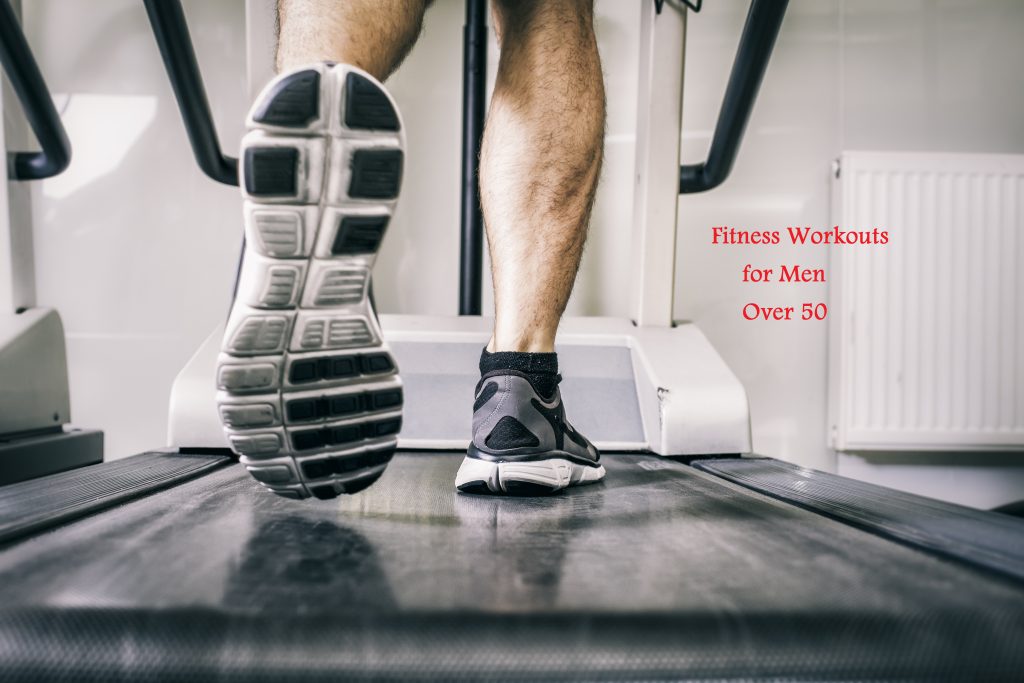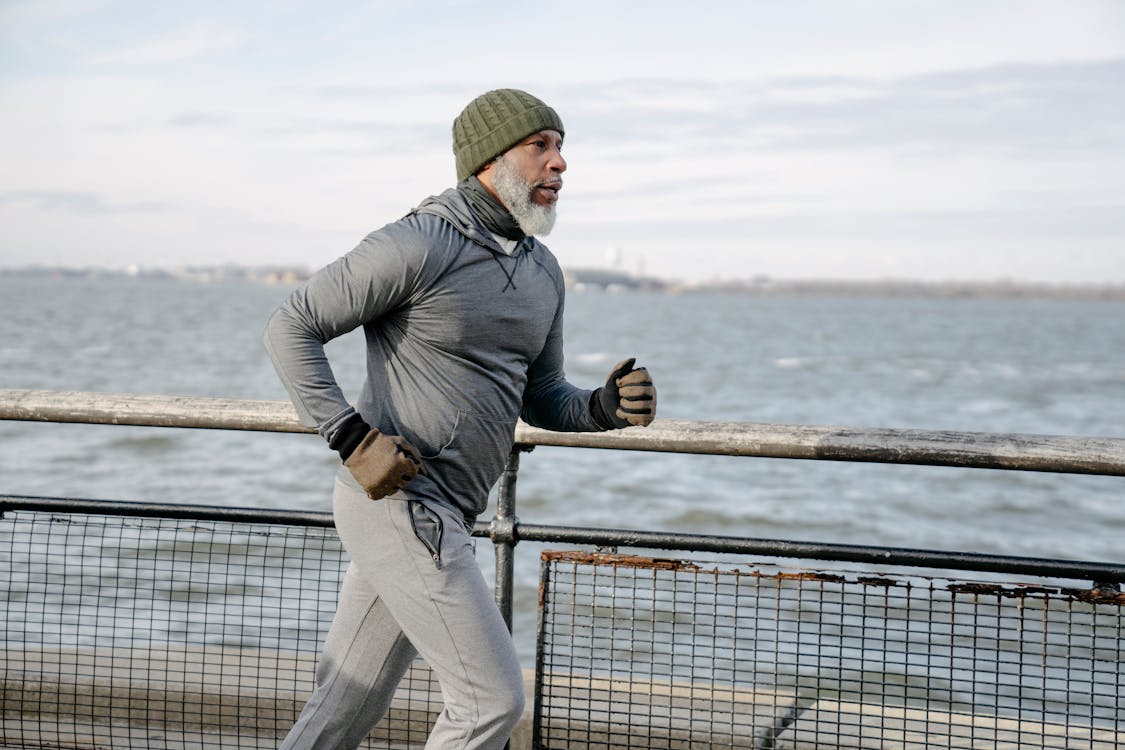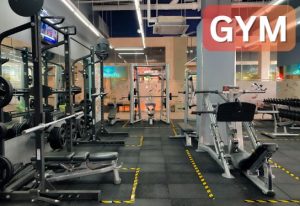
As men age, maintaining an active and healthy lifestyle becomes increasingly important. Regular exercise not only improves physical fitness but also enhances mental well-being, boosts energy levels, and reduces the risk of various health conditions. Today, we will explore some effective fitness workouts for men over 50. These workouts are designed to promote strength, flexibility, cardiovascular health, and overall vitality. Let’s dive into the world of fitness and discover the best workout routines for men in their golden years.
Before Fitness Workouts for Men Over 50:

Consultation with Your Doctor: Before you lace up your sneakers and hit the gym, scheduling a visit to your healthcare provider is paramount. Your doctor can provide valuable insights into your current health status, potential limitations, and any underlying medical conditions that might affect your exercise regimen. This step ensures that you’re embarking on a fitness journey that’s safe and tailored to your individual needs.
Gradual and Mindful Start: Remember, Rome wasn’t built in a day, and neither is a healthy exercise routine. It’s crucial to commence your workouts gradually to give your body time to adapt. Overexertion can lead to unnecessary injuries or setbacks. Begin with low-impact activities that place less strain on your joints, and gradually ramp up the intensity and duration as your body adjusts and gains strength.
Prioritize Strength Training: One of the key challenges men over 50 face is the gradual decline in muscle mass. Engaging in regular strength training can be a game-changer. By incorporating resistance exercises like weight lifting, bodyweight exercises, and resistance bands, you can counteract muscle loss, enhance bone density, and boost your metabolism. A stronger musculoskeletal system contributes to improved functional fitness and a higher quality of life.
Balanced Cardiovascular Conditioning: Cardiovascular exercise isn’t just for the young – it’s an essential component of maintaining heart health and endurance as you age. Engaging in activities like brisk walking, cycling, swimming, or even dancing can elevate your heart rate and improve circulation. Aim for consistency, with at least 150 minutes of moderate-intensity aerobic exercise each week, or if you’re up for a challenge, opt for 75 minutes of vigorous-intensity exercise.
Flexibility and Stretching: Don’t neglect the importance of maintaining flexibility and suppleness in your muscles and joints. Incorporate stretching exercises into your routine to enhance your range of motion, prevent injuries, and ease muscle tension. Prioritize dynamic stretches before your workout to warm up your body and static stretches post-workout to cool down and promote recovery.
Mastering Proper Technique: Executing exercises with proper form is akin to building a sturdy foundation for your fitness progress. Poor form not only lessens the effectiveness of your workouts but also increases the risk of injury. If you’re new to a particular exercise or unsure about your technique, consider working with a knowledgeable fitness professional or personal trainer. They can guide you through the correct posture, movement patterns, and breathing techniques.
Tuning into Your Body: Your body is an intricate mechanism that deserves attention and respect. As you age, it’s natural for recovery times to elongate. Be attuned to your body’s signals – if you’re feeling overly fatigued or notice persistent discomfort, it might be time to scale back or take an extra rest day. Remember, the goal is sustainable progress, not pushing yourself to the point of burnout.
Embrace the Journey: The journey to improved fitness and well-being is a marathon, not a sprint. Cultivate a positive mindset that embraces the process. Celebrate each small victory – whether it’s adding an extra rep, walking an additional mile, or simply feeling more energetic. A positive attitude can work wonders, keeping you motivated and committed to your goals.
Strength Training Workouts for Men Over 50:

Strength training forms the foundation of any effective fitness regimen, especially for men over 50. It helps to counteract muscle loss, increase bone density, and improve overall functional fitness. Here are some key exercises:
Squats: Squats are excellent for building lower body strength and stability. Start with bodyweight squats and gradually progress to using dumbbells or a barbell.
Push-ups: Push-ups engage multiple muscle groups, including the chest, shoulders, and triceps. Modify the exercise by doing push-ups against a wall or using an inclined surface if needed.
Dumbbell Rows: Dumbbell rows strengthen the upper back muscles, promoting better posture and reducing the risk of back pain. Use a weight that challenges you without compromising form.
Lunges: Lunges are fantastic for targeting the legs and glutes while also enhancing balance and coordination. Begin with basic forward lunges and gradually explore reverse lunges and lateral lunges for variety.
Overhead Shoulder Press: This exercise focuses on the shoulder muscles and helps to maintain upper body strength. Use dumbbells or a barbell and ensure proper shoulder alignment throughout the movement.
Planks: Planks are an effective core-strengthening exercise that also engages the shoulders, back, and legs. Start with shorter holds and gradually work your way up to longer durations as your core strength improves.
Leg Press: If you have access to a gym, the leg press machine can be a valuable addition. It targets the quadriceps, hamstrings, and glutes, supporting overall lower body strength.
Lat Pulldowns: Using a lat pulldown machine or resistance bands, lat pulldowns strengthen the muscles in your upper back, promoting a balanced and strong upper body.
Deadlifts: Deadlifts are a compound exercise that engages multiple muscle groups, including the legs, back, and core. Focus on proper form and start with lighter weights before gradually increasing the load.
Bicep Curls: While focusing on compound movements is crucial, isolation exercises like bicep curls can also have their place. Use dumbbells or resistance bands to target the biceps effectively.
Stability Ball Exercises: Incorporating stability balls can enhance core strength and stability. Try exercises like stability ball squats, bridges, and planks to engage various muscle groups.
Creating Your Strength Training Routine:
Designing a well-rounded strength training routine involves more than just selecting exercises. Consider the following aspects to tailor a program that suits your needs:
Frequency: Aim for at least two to three strength training sessions per week. This frequency allows your muscles adequate time to recover while still providing the stimulus they need to grow stronger.
Progressive Overload: Continuously challenge your muscles by gradually increasing the weight, resistance, or intensity of your exercises. This principle of progressive overload ensures that you’re making consistent gains.
Variation: Keep your workouts engaging by introducing different exercises and variations. This not only prevents boredom but also ensures that you’re targeting all major muscle groups from various angles.
Warm-Up and Cool-Down: Prioritize warming up with dynamic stretches and light cardio to prepare your muscles for the workout. After your session, cool down with static stretches to promote flexibility and aid recovery.
Rest and Recovery: Adequate rest is essential for muscle repair and growth. Listen to your body and allow for rest days between intense strength training sessions. Overtraining can lead to injury and burnout.
Nutrition and Hydration: Support your strength training efforts with a balanced diet rich in protein, which is crucial for muscle repair. Stay hydrated to optimize your performance and recovery.
Consult a Professional: If you’re new to strength training or have any health concerns, consider working with a qualified fitness trainer. They can provide guidance on proper form, technique, and progression. Additionally, consider seeking medical advice if you have any pre-existing health conditions.
Set Goals and Track Progress: Define your fitness goals, whether they involve strength gains, weight loss, or improved functional abilities. Keep a workout journal or use a fitness app to track your progress and make necessary adjustments to your routine.
Cardiovascular Workouts for Men Over 50:

Engaging in regular cardiovascular exercise is crucial for maintaining heart health, boosting endurance, and burning calories. Consider the following activities:
a. Walking: Brisk walking is a low-impact exercise that is easy on the joints. Aim for at least 30 minutes of brisk walking most days of the week.
b. Cycling: Cycling is a great cardiovascular workout that is gentle on the joints. Whether it’s outdoor cycling or using a stationary bike, it helps strengthen the leg muscles and improve overall cardiovascular fitness.
c. Swimming: Swimming is a low-impact, full-body exercise that is gentle on the joints. It offers an excellent cardiovascular workout while reducing the risk of injury.
d. Jogging: If you’re accustomed to running, jogging can be a sustainable alternative as you age. It places less stress on the joints while still providing a solid cardiovascular workout. Consider mixing jogging with brisk walking to find the right balance.
e. Dancing: Dancing isn’t just enjoyable; it’s also a fantastic cardiovascular exercise. Whether you’re into ballroom, salsa, or even Zumba, dancing gets your heart rate up and improves coordination.
f. Hiking: If you enjoy spending time outdoors, hiking is a wonderful way to combine cardiovascular exercise with the beauty of nature. Research local trails and gradually increase the difficulty level as you become more comfortable.
g. Rowing: Using a rowing machine provides a full-body workout that engages your upper and lower body muscles while also improving cardiovascular endurance.
h. Aerobic Classes: Joining a group aerobic class can be both motivating and effective. These classes often incorporate a mix of cardio exercises, helping you stay engaged and challenged.
i. Elliptical Training: The elliptical machine offers a low-impact alternative to running while still delivering an effective cardiovascular workout. It engages both the upper and lower body, making it a well-rounded option.
j. Jump Rope: Jumping rope might evoke childhood memories, but it’s an excellent cardiovascular exercise. It’s simple, cost-effective, and can be done almost anywhere.
k. High-Intensity Interval Training (HIIT): HIIT involves alternating between short bursts of intense exercise and periods of rest. It’s a time-efficient way to improve cardiovascular fitness and burn calories.
Creating Your Cardiovascular Routine:
Designing a cardiovascular routine that suits your preferences and fitness level is essential. Here’s how to go about it:
- Warm-Up and Cool-Down: Begin your cardiovascular workout with a brief warm-up to prepare your muscles and gradually elevate your heart rate. Afterward, cool down with some gentle stretching to aid recovery.
- Progressive Approach: If you’re new to cardiovascular exercise or returning after a break, start slowly and gradually increase the intensity and duration over time. This minimizes the risk of injury and helps your body adapt.
- Mix It Up: Variety keeps your workouts interesting and challenges different muscle groups. Incorporate a mix of activities to prevent boredom and ensure a balanced fitness routine.
- Listen to Your Body: Pay attention to how your body responds to different activities. If an exercise causes discomfort or pain, adjust your routine accordingly or consult a fitness professional.
- Consistency: Aim for at least 150 minutes of moderate-intensity aerobic exercise or 75 minutes of vigorous-intensity aerobic exercise per week. This can be spread out over several days.
- Recovery: Give your body time to recover between intense cardiovascular sessions. Incorporate active recovery activities like gentle walking or stretching on rest days.
- Stay Hydrated and Fuel Up: Cardiovascular exercise can be quite demanding, so stay hydrated and fuel your body with nutritious foods that support your energy levels.
- Medical Considerations: If you have any underlying health conditions or concerns, consult your healthcare provider before starting a new exercise routine.
Incorporating regular cardiovascular workouts into your routine can have a profound impact on your overall health and well-being. It’s not just about staying fit; it’s about nurturing your cardiovascular system and reaping the benefits of increased energy, improved mood, and enhanced endurance. Remember, age is just a number, and it’s never too late to prioritize your cardiovascular health and enjoy the positive effects it brings to your life.
Video: Best Exercises For Men Over 50
Flexibility and Balance Workouts for Men Over 50:

Maintaining flexibility and balance is essential for men over 50 to prevent injuries and maintain overall mobility. Include these exercises in your routine:
a. Yoga: Yoga combines stretching, balance, and relaxation. It helps improve flexibility, strengthen muscles, and enhance mental well-being.
b. Tai Chi: Tai Chi is a gentle martial art that focuses on slow, controlled movements and deep breathing. It improves balance, and flexibility, and reduces stress.
c. Pilates: Pilates is a low-impact exercise that emphasizes core strength, flexibility, and body awareness. It’s particularly beneficial for improving posture and balance.
d. Stretching: Incorporate a variety of stretching exercises that target different muscle groups. Focus on both static stretches (holding a stretch) and dynamic stretches (stretching while moving) to improve flexibility and range of motion.
e. Balance Exercises: Include balance-enhancing movements such as single-leg stands, heel-to-toe walks, and balancing on one leg with your eyes closed. These exercises help improve stability and reduce the risk of falls.
f. Foam Rolling: Foam rolling is a form of self-myofascial release that helps release tension in muscles and improve flexibility. Incorporate foam rolling as part of your warm-up or cool-down routine.
g. Resistance Band Exercises: Resistance bands can be used to perform a variety of stretching and mobility exercises. They can help you achieve deeper stretches and improve flexibility over time.
h. Dynamic Movement: Engage in dynamic activities like dynamic lunges, leg swings, and arm circles. These movements help to increase blood flow to your muscles, improve joint mobility, and enhance overall flexibility.
i. Balance Challenges: As you become more comfortable with basic balance exercises, gradually introduce challenges like standing on an unstable surface (such as a foam pad) or performing exercises with your eyes closed.
j. Active Recovery: On rest days, consider engaging in gentle activities like leisurely walks, swimming, or easy cycling. These activities promote blood flow and aid in recovery while maintaining your flexibility and balance.
Creating Your Flexibility and Balance Routine:
Crafting a routine that emphasizes flexibility and balance requires careful planning. Here’s how to go about it:
- Warm-Up: Prioritize warming up your muscles with light cardio and dynamic stretches before diving into flexibility and balance exercises.
- Progressive Stretching: Start with gentle stretches and gradually work your way into deeper stretches. Avoid pushing your body too far, and focus on maintaining proper form.
- Hold and Breathe: When stretching, hold each position for about 15-30 seconds and focus on deep, steady breathing. Avoid bouncing or forcing the stretch.
- Balance Progression: Begin with simple balance exercises and gradually increase the complexity. Challenge yourself, but always prioritize safety and stability.
- Consistency: Aim to incorporate flexibility and balance exercises at least a few times a week. These exercises can be integrated into your warm-up, cool-down, or as standalone sessions.
- Stay Hydrated and Nourished: Proper hydration and nutrition support muscle function and aid recovery, which is vital for maintaining flexibility and balance.
- Rest and Recovery: Just like any other aspect of fitness, rest is crucial. Allow your muscles time to recover and adapt to the new demands you’re placing on them.
- Professional Guidance: If you’re new to flexibility and balance exercises or have any existing health concerns, consider working with a fitness professional or physical therapist to ensure you’re performing the exercises correctly and safely.
Remember, flexibility and balance are lifelong pursuits. By integrating these exercises into your routine, you’ll not only enhance your physical capabilities but also reduce the risk of injuries and maintain the freedom to move comfortably as you age. Embrace the journey of improving your flexibility and balance, and enjoy the increased overall well-being that comes with it.
Functional Training Workouts for Men Over 50:
Functional training exercises mimic movements used in daily activities and help improve overall functionality and mobility. Some essential exercises include:
a. Planks: Planks engage the core muscles and help strengthen the back, which is crucial for maintaining good posture and preventing back pain.
b. Lunges: Lunges target the lower body muscles and promote stability and balance. They also help improve hip mobility.
c. Medicine Ball Twists: Medicine ball twists engage the core muscles and improve rotational strength, which is important for activities like golf, tennis, or reaching for objects.
d. Step-Ups: Step-ups simulate everyday activities like climbing stairs or stepping onto curbs. They strengthen the lower body and enhance balance.
e. Farmer’s Carry: This exercise involves holding weights (dumbbells or kettlebells) in each hand and walking. It improves grip strength, core stability, and overall functional strength.
f. Standing Leg Raises: Standing leg raises target the hip flexors and improve hip mobility. This is important for movements like lifting and bending.
g. Squat to Press: Combining a squat with an overhead press mimics the motion of lifting objects from the ground and placing them overhead. It engages multiple muscle groups and enhances full-body coordination.
h. Deadbugs: Deadbugs challenge core stability and improve the mind-muscle connection. This exercise can be particularly helpful for maintaining balance and stability.
i. Seated Row: The seated row exercise focuses on the muscles of the upper back and shoulders. It improves posture and helps counteract the effects of sitting for prolonged periods.
j. Stability Ball Wall Squats: Using a stability ball against a wall while squatting engages the core and lower body muscles while improving balance and coordination.
k. Functional Balance Exercises: Incorporate exercises that challenge your balance, such as standing on one leg, walking heel-to-toe, or doing single-leg reaches. These exercises enhance stability and reduce the risk of falls.
Creating Your Functional Training Routine:
Designing a functional training routine requires careful consideration of movement patterns and goals. Here’s how to structure your routine:
- Assess Your Needs: Identify areas of your daily life that may benefit from improved functionality, such as lifting objects, climbing stairs, or bending down.
- Functional Movements: Choose exercises that mimic these daily activities. Prioritize compound movements that engage multiple muscle groups.
- Warm-Up and Cool-Down: Begin with dynamic warm-up exercises to prepare your body for movement. After your workout, cool down with static stretches and gentle mobility exercises.
- Progressive Overload: Gradually increase the weight or resistance as your strength improves. This helps to continuously challenge your muscles and promote growth.
- Variety: Incorporate a variety of exercises to engage different muscle groups and movement patterns. This also prevents boredom and ensures a balanced workout.
- Mindful Movement: Focus on proper form and technique throughout each exercise. This not only prevents injury but also ensures that you’re engaging the right muscles.
- Rest and Recovery: Allow adequate time for your muscles to recover between sessions. This promotes muscle repair and growth.
- Functional Mindset: Keep the functional aspect in mind as you perform each exercise. Visualize the movements you’re training for, and consider how they translate to your daily life.
- Professional Guidance: If you’re new to functional training or have specific concerns, consider consulting a fitness professional. They can help design a program tailored to your needs and goals.
- Consistency: Aim for regular functional training sessions, ideally two to three times a week, to see meaningful improvements in your functional fitness.
Functional training isn’t just about looking fit; it’s about enhancing your ability to navigate daily life with strength, stability, and confidence. By incorporating these exercises into your routine and staying consistent, you’re investing in your long-term well-being and maintaining the physical independence that allows you to enjoy life to the fullest as you age.
Conclusion:
Fitness is a lifelong journey, and age should never be a barrier to achieving optimal health. As men over 50, it’s essential to engage in regular exercise to maintain physical fitness, flexibility, and overall well-being. Incorporate a balanced routine that includes strength training, cardiovascular exercise, flexibility and balance exercises, and functional training. Remember to start at your own pace, listen to your body, and gradually increase the intensity and duration of your workouts. Stay consistent, challenge yourself, and enjoy the numerous benefits that an active lifestyle can bring to your life. Embrace fitness and make the most of your golden years!




